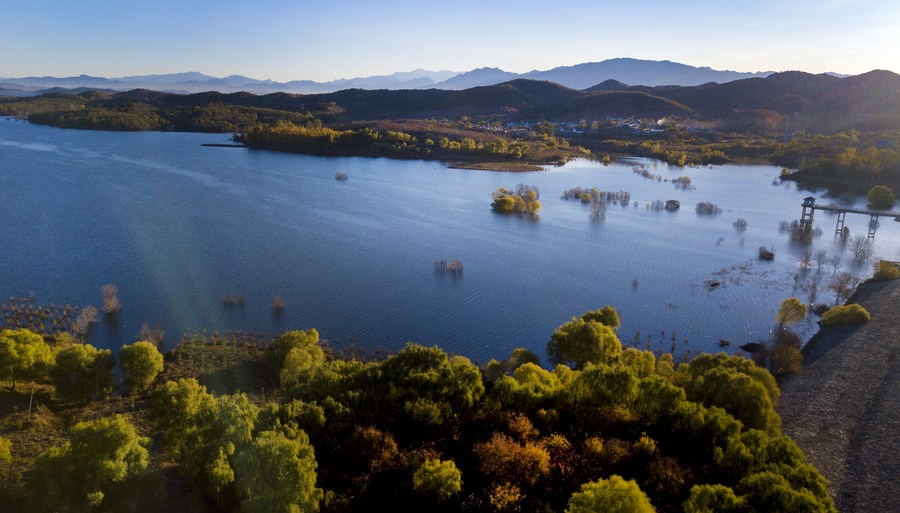
Photo taken on Oct. 30, 2018 shows the autumn scenery at Miyun reservoir, the capital city's major reserve of drinking water, in Beijing, capital of China. (Xinhua/Du Huaju)
BEIJING, Aug. 31 (Xinhua) -- Continuous protection measures for the Miyun Reservoir in the northeast suburbs of Beijing have ensured adequate water supply for the capital and highlighted the importance of ecological civilization.
The reservoir with a capacity of around 4.4 billion cubic meters, will mark its 60th anniversary on Tuesday.
Construction started in 1958 to meet increasing water demand as the capital developed and expanded. A total of 200,000 farmers and workers toiled on the massive earthwork and masonry to build the reservoir.
"There was not much machinery involved, and workers carried stones and boulders in baskets on their backs," said Luo Lianheng, who was involved in the intense building effort. After 700 days of hectic construction, the reservoir was completed in September, 1960.
From 1958 to 2003, 69,000 people had to move their houses to make way for the reservoir and ancillary facilities. The reservoir also took up about 19,000 hectares of farmland. In the process, fishing infrastructure was removed, and over 300 companies were shut down.
The reservoir, along with other smaller water bodies, supplied the capital in the parched north.
Over the past 60 years, Miyun Reservoir provided over 39 billion cubic meters of water to Beijing and neighboring areas. A saying goes: "when a person in Beijing drinks three cups of water, two of them come from the Miyun Reservoir."
However, the reservoir had been operating below capacity for years due to reduced flow from upstream rivers until it was filled up by water from the south.
From December 2014, water began to be channeled from central China's Hubei Province to Beijing via the south-north water diversion project. Miyun Reservoir is a major facility for storing water from the project.
"Water is Miyun's first and foremost responsibility," said Pan Linzhu, Communist Party chief of Miyun District.
The people in Miyun are determined to ensure the quality and supply of water through increased protection measures, more manpower, and attention to environment, he said.
A core area of 273 square kilometers around the water body is under top-level protection, while some measures are applied to an area of 2,841 sq km, even larger than that of Miyun.
Guo Qindong has worked on the reservoir for over 22 years. He and his team mates patrol the reservoir around the clock.
"We must protect the water like we protect our eyes," he said.
Their job includes and is not limited to discovering and stopping fishing, swimming, herding, or activities that may damage the reservoir facilities or pollute the water.
Over 390 cameras are being installed as part of a smart monitoring system. More than 2,000 farmers have been hired to assist patrolling. Among those hired is Han Chunfeng, a 50-year-old woman from Shimayu village who had to shut down her chicken farm in the protection drive.
"Local residents in Miyun have made great sacrifices in conserving the critical water source of Beijing. We are exploring a way that can both protect water and bring wealth to the people," said Pan.
Rural tourism is being developed with caution. In 2019, Miyun District received 8.3 million tourists. Local government is helping poor households to increase income by planting chestnuts, grapes and pears, and farming honey. ■



